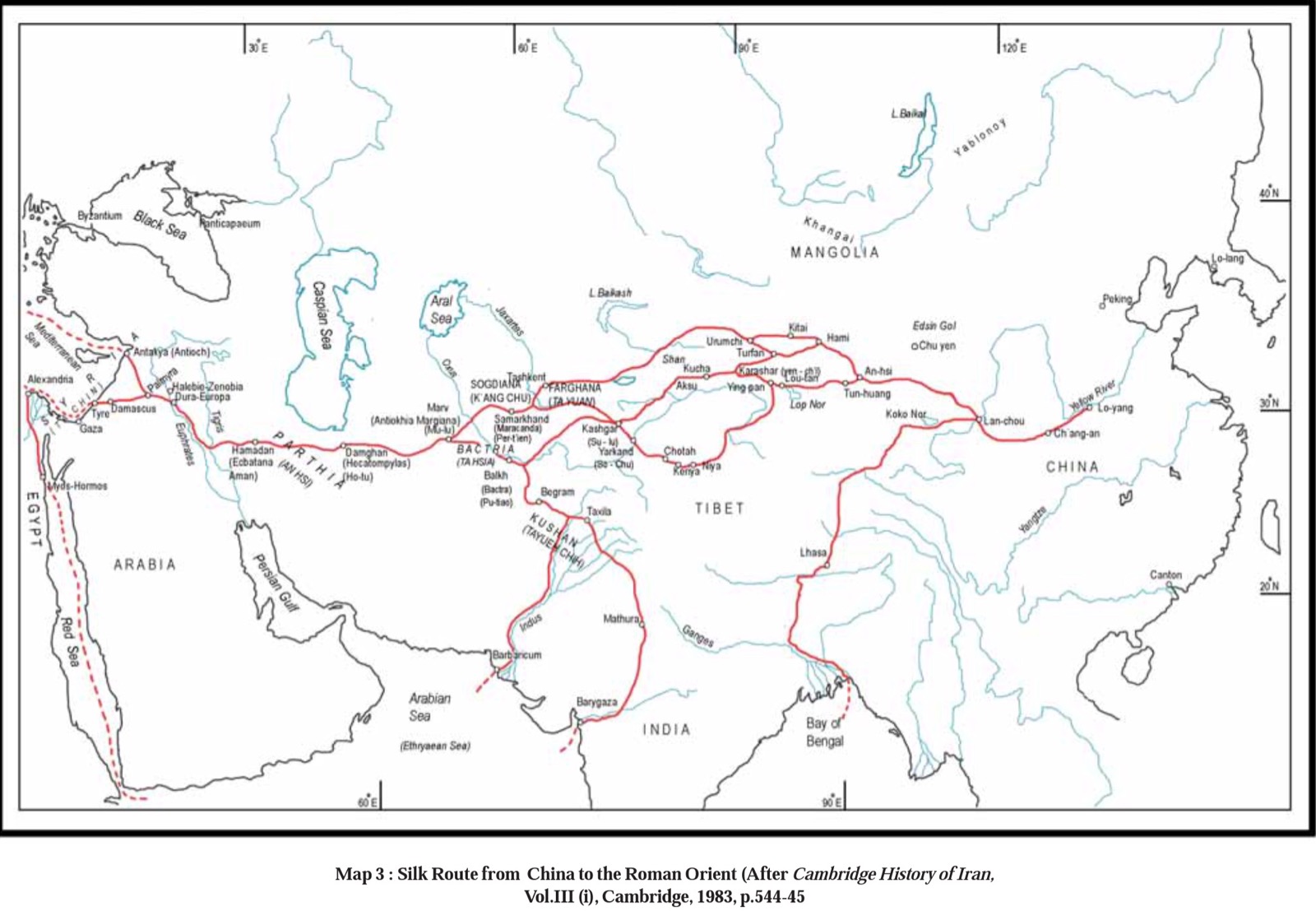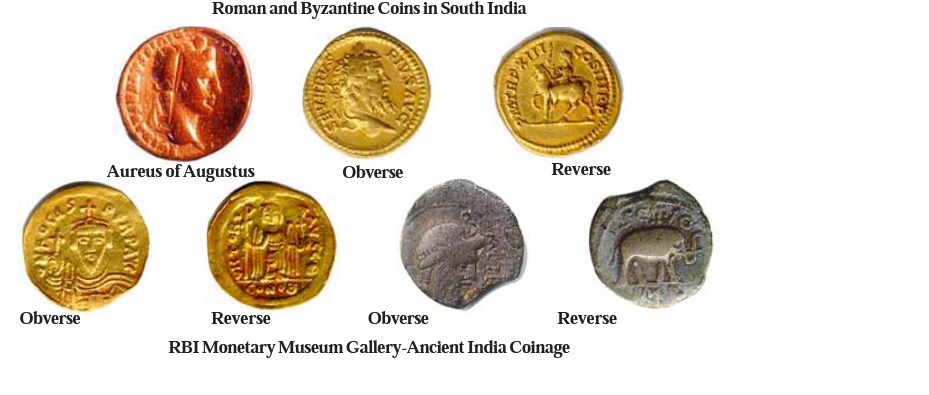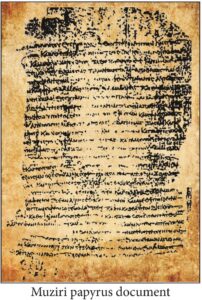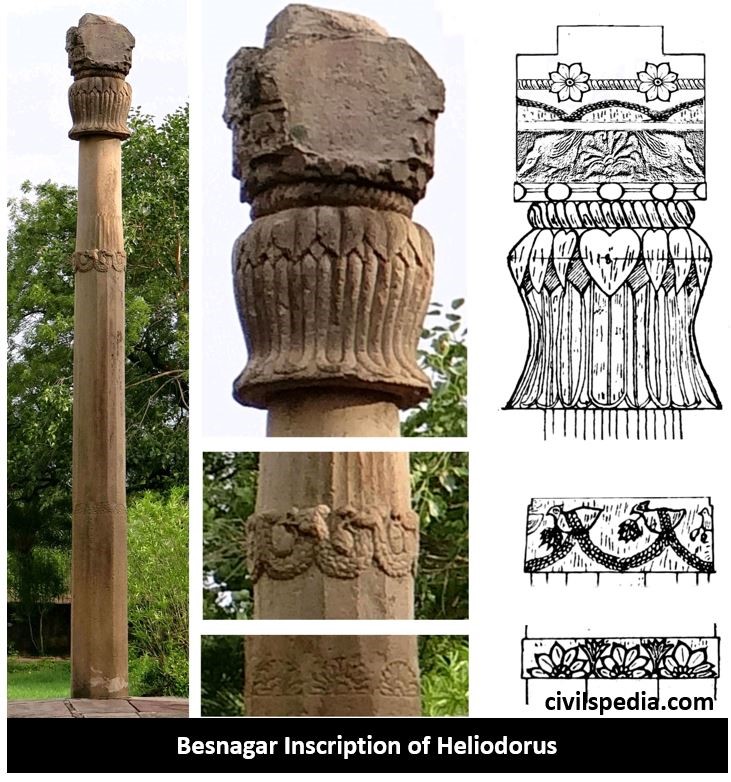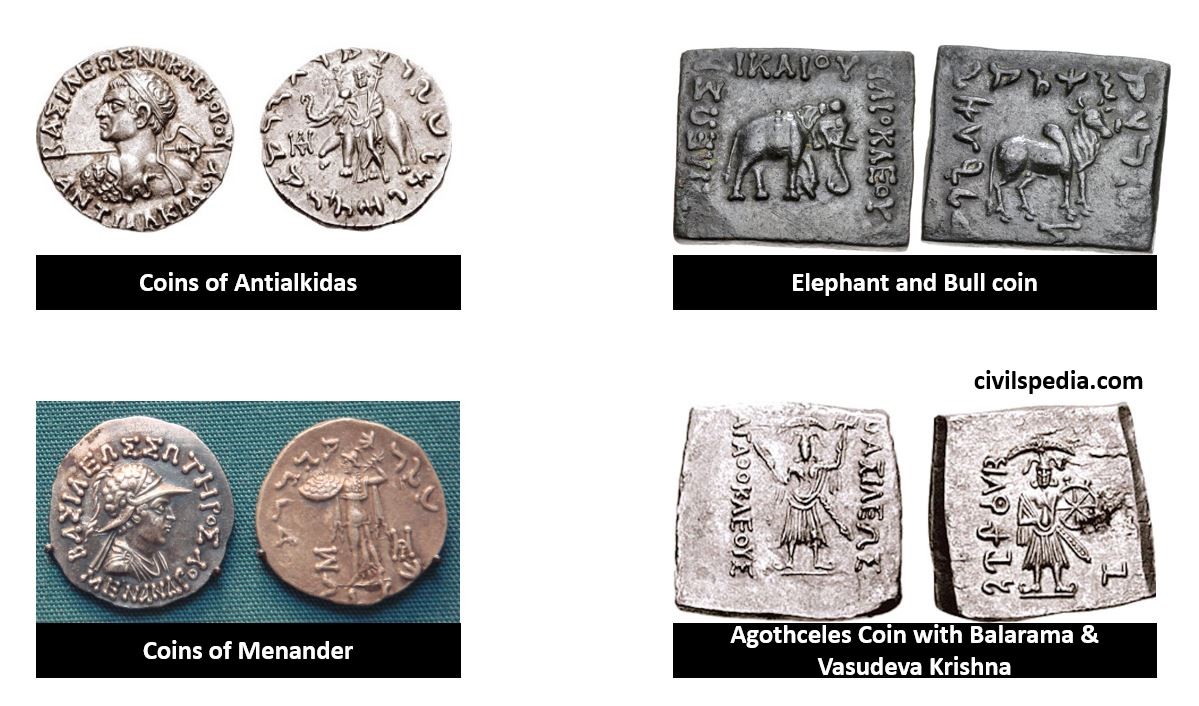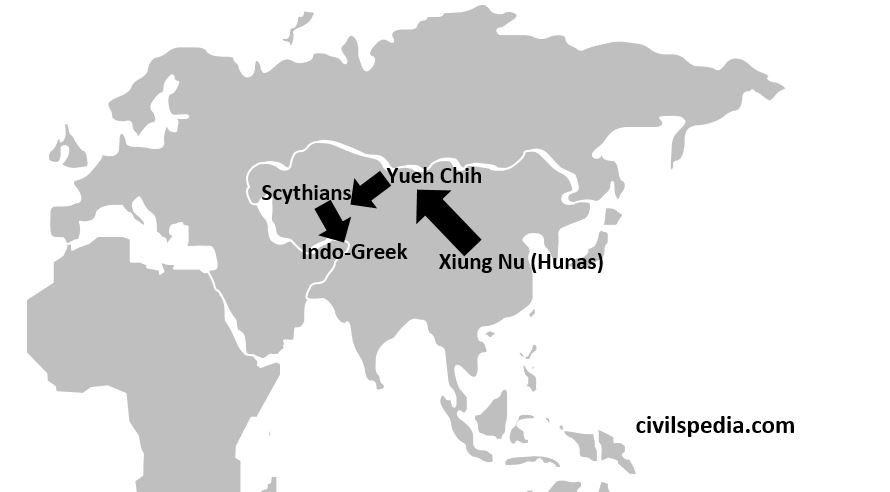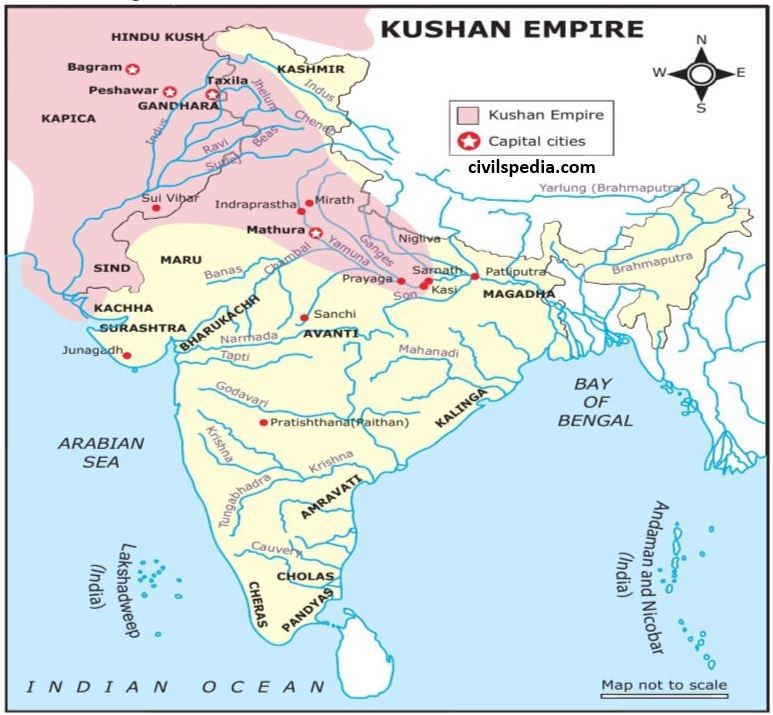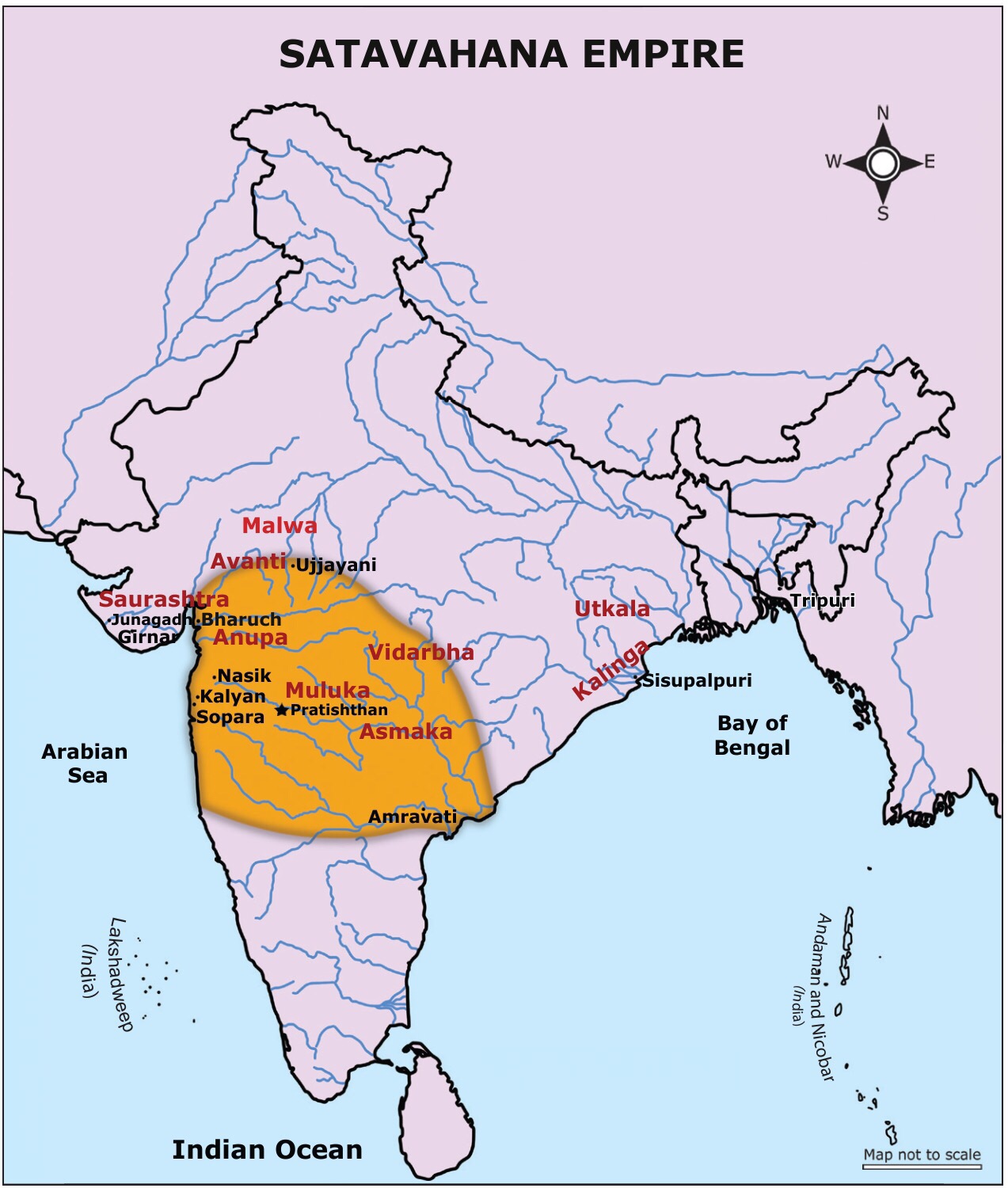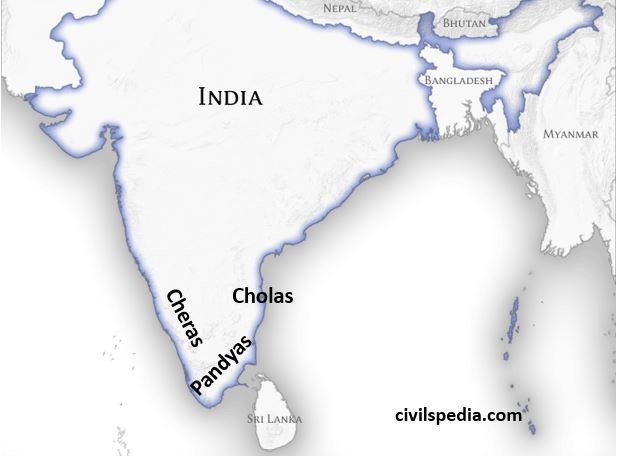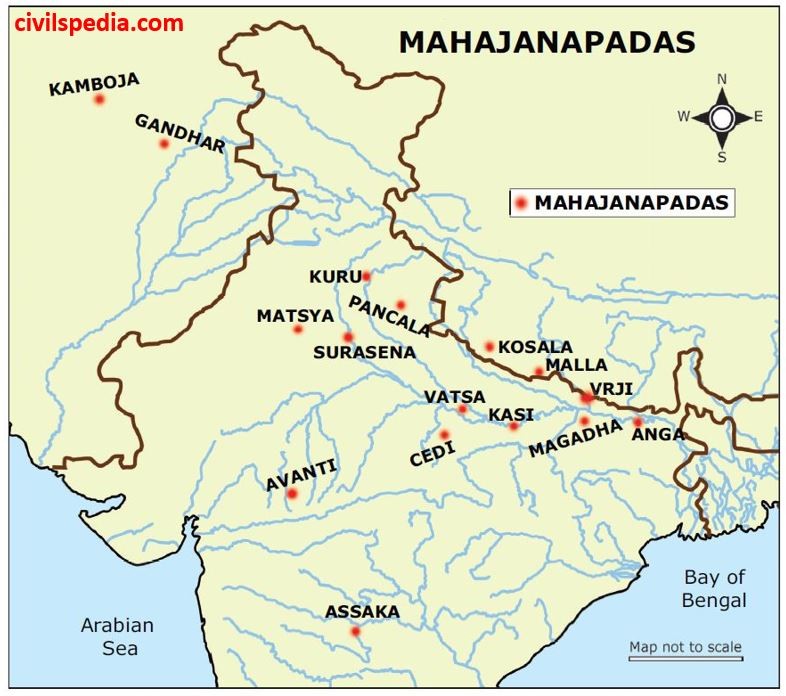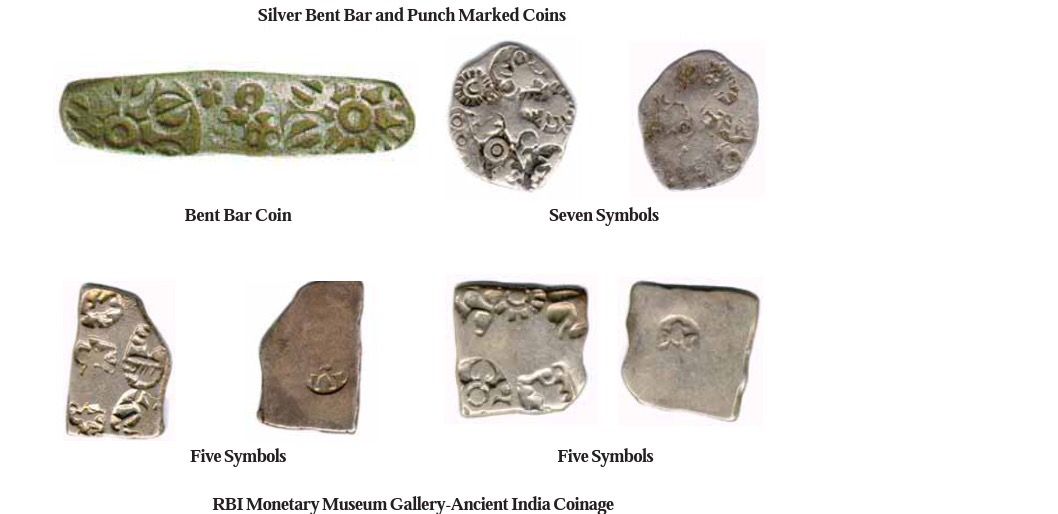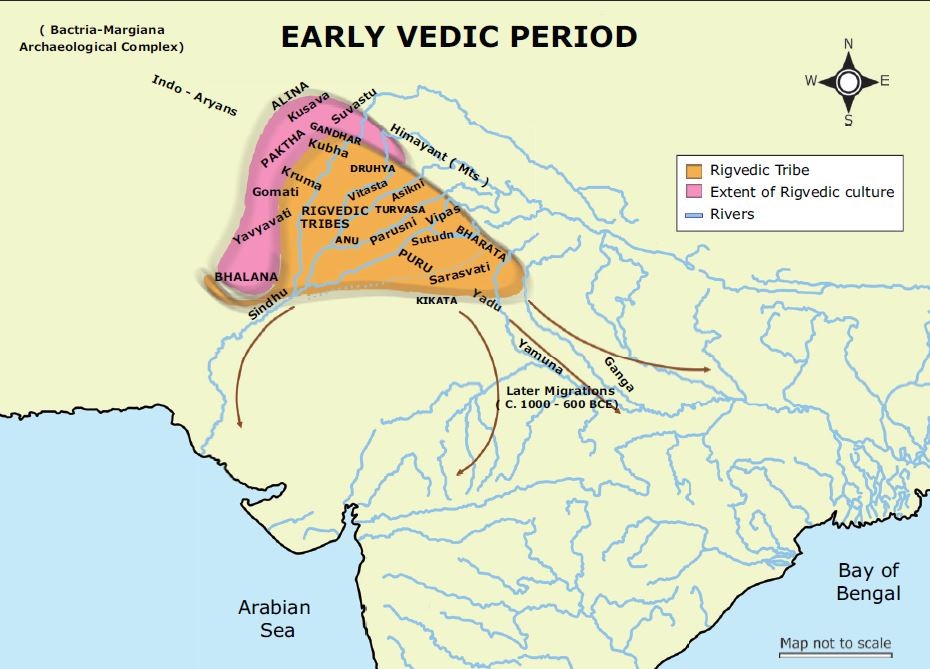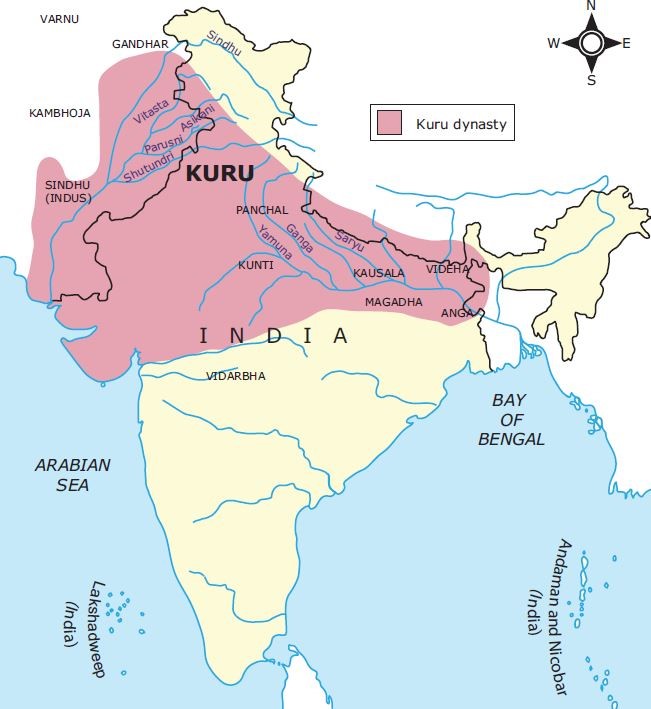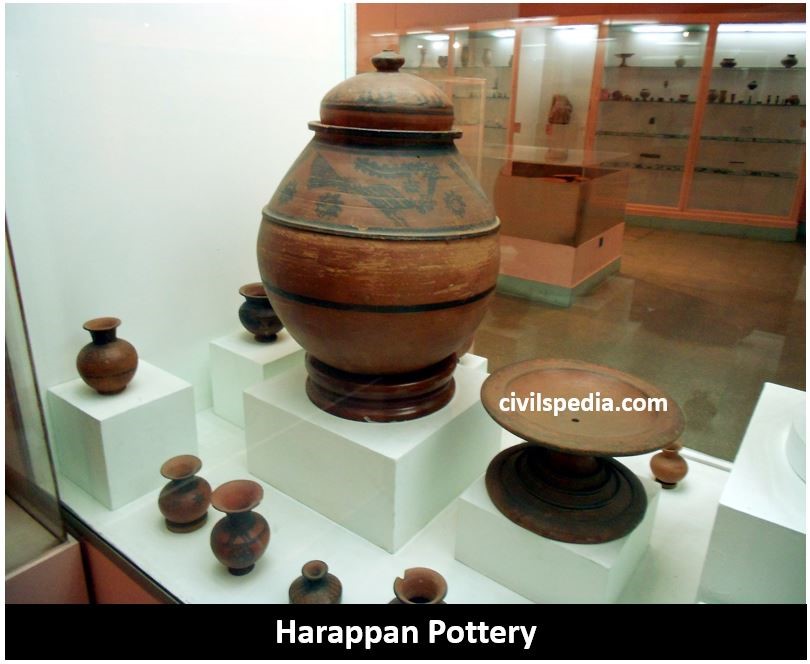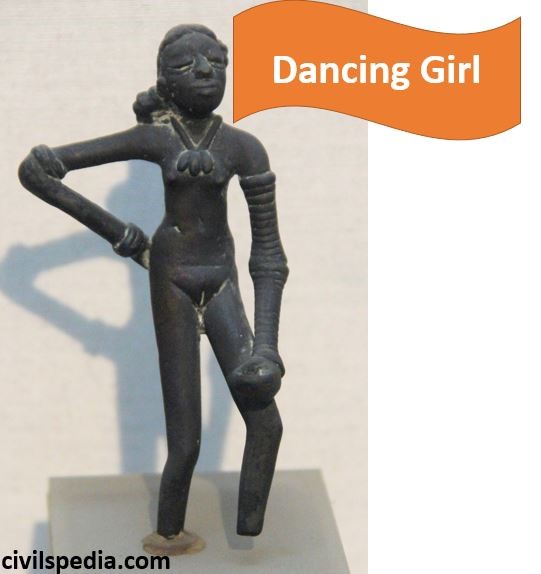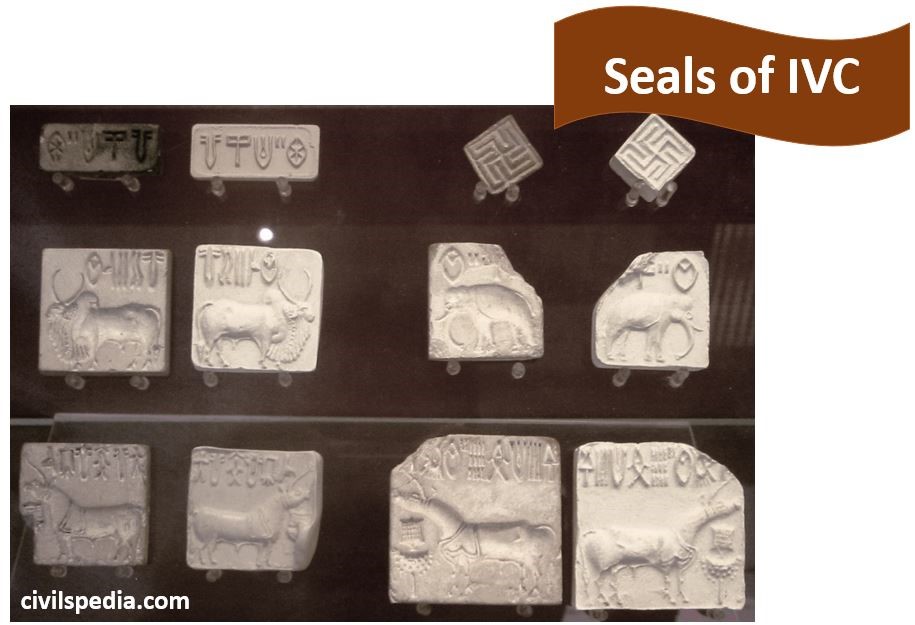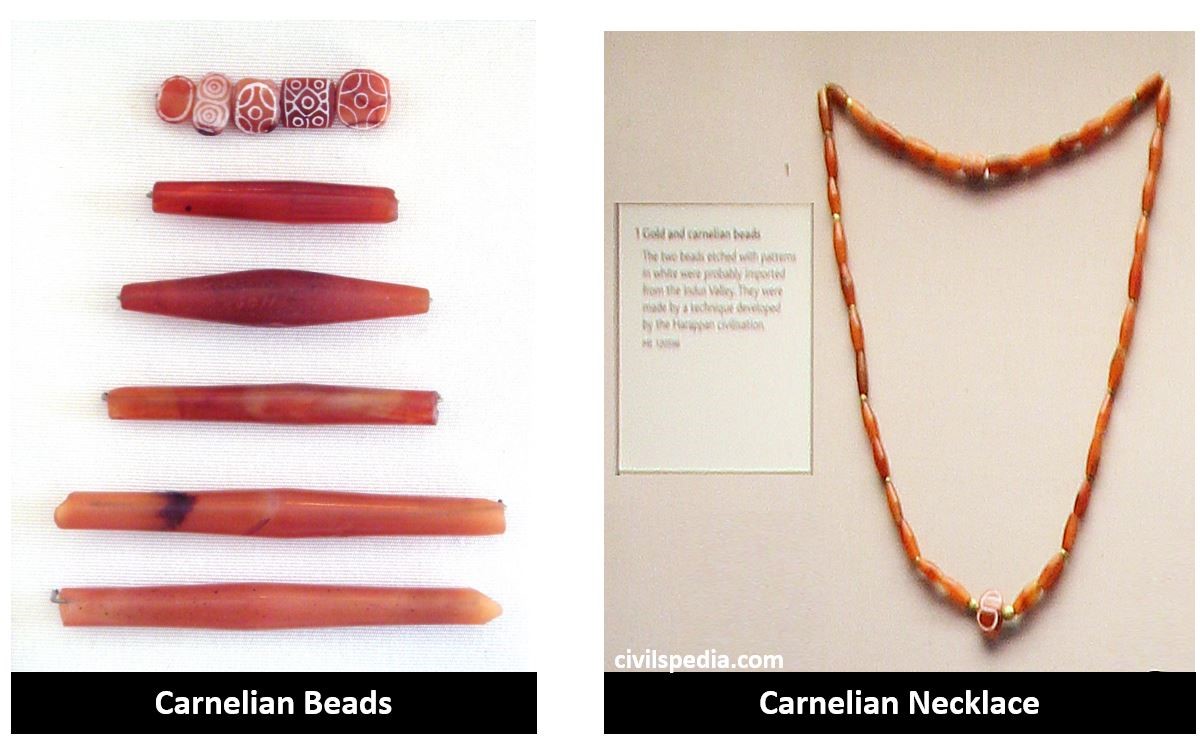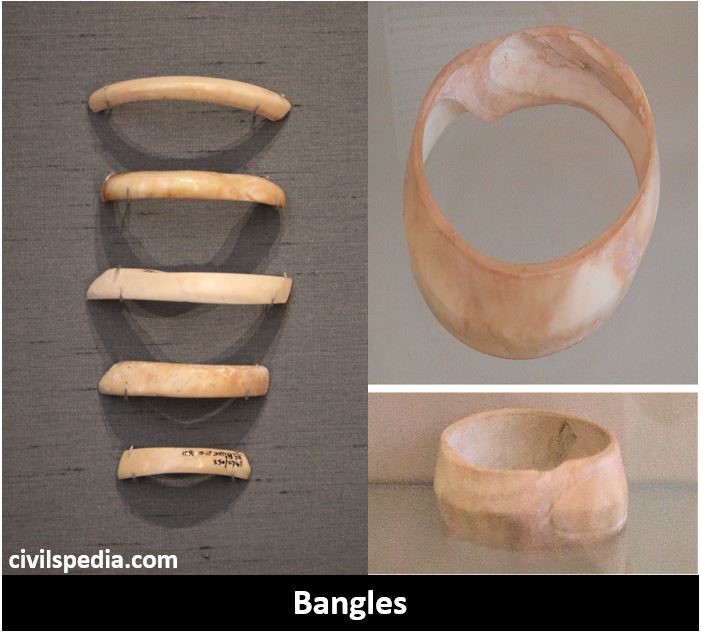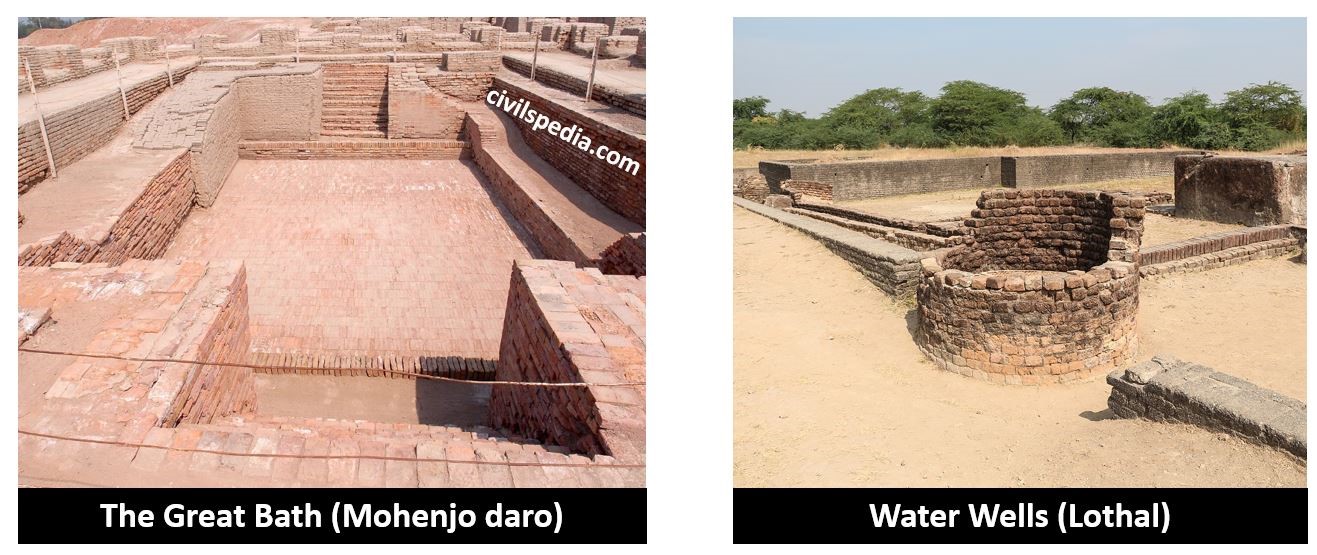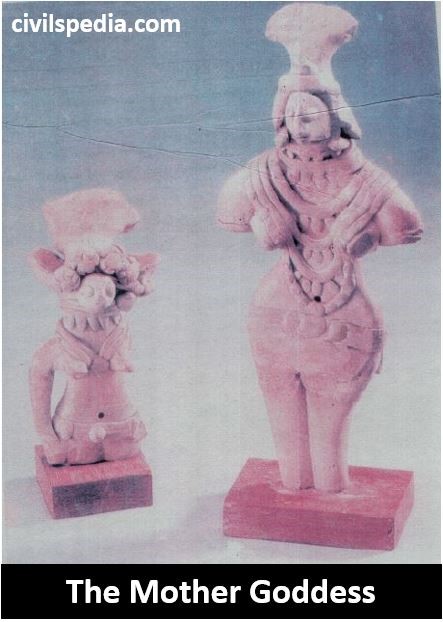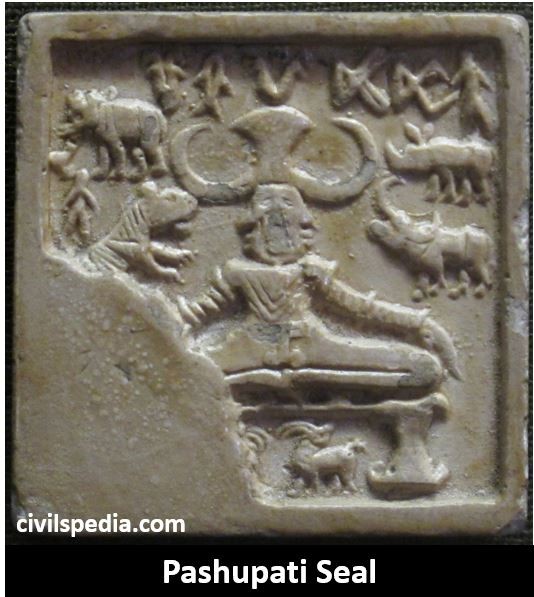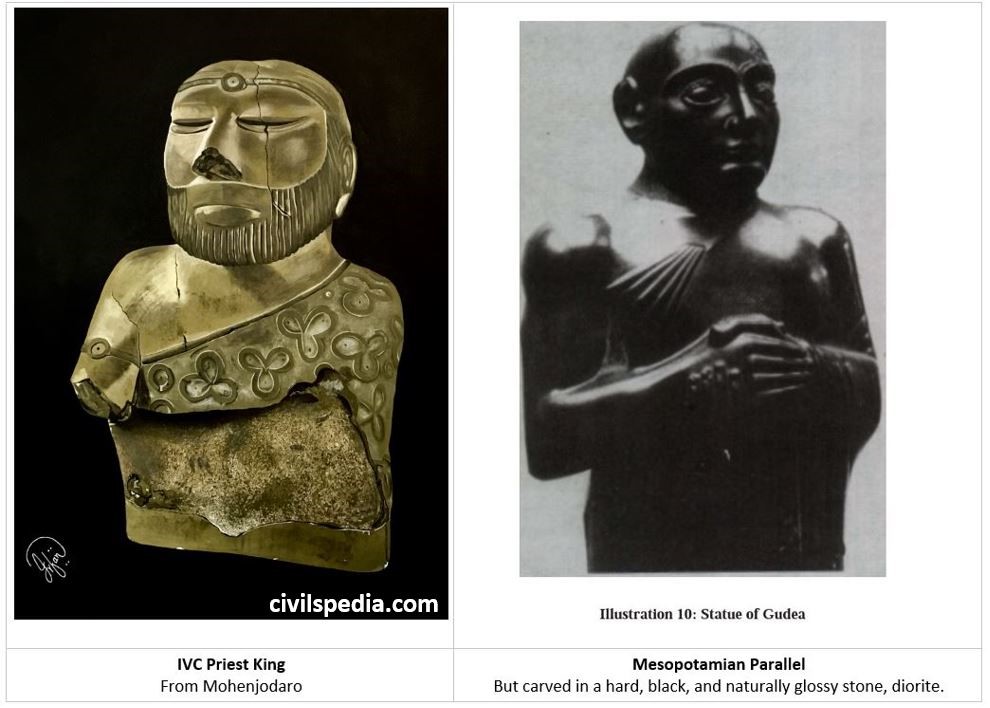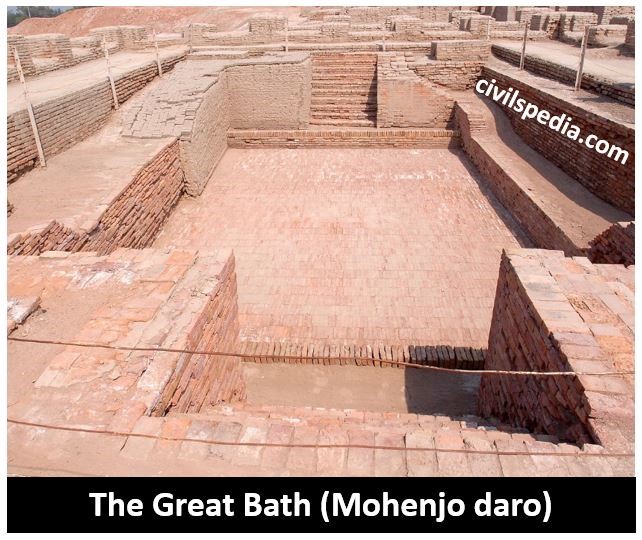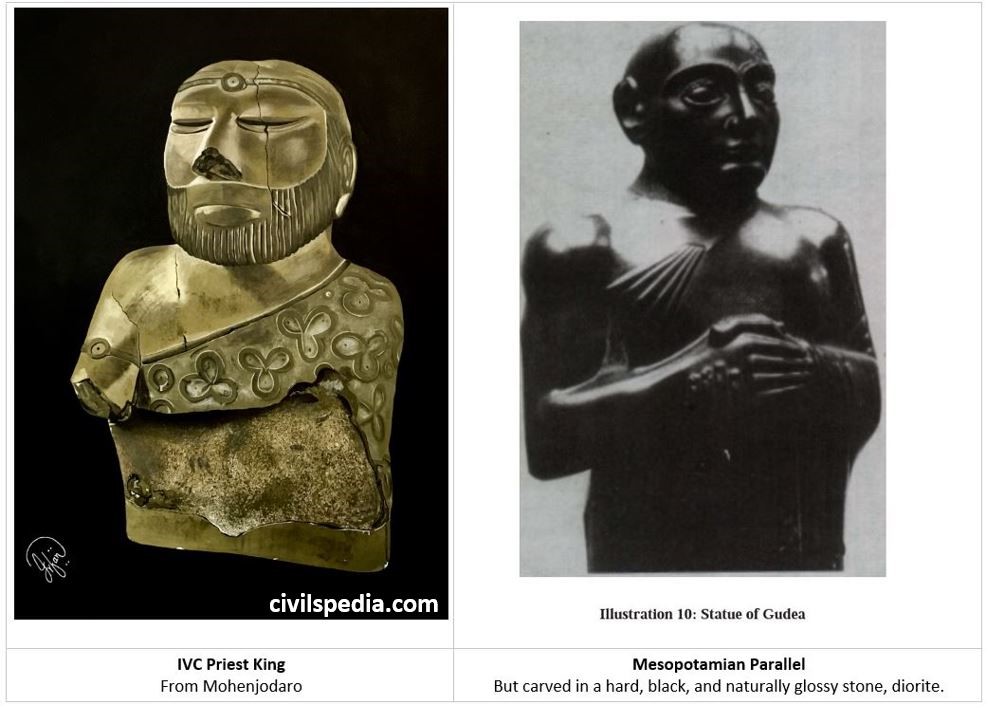Last Update: June 2023 (The Gupta Empire)
The Gupta Empire
This article deals with ‘The Gupta Empire ’ . This is part of our series on ‘Ancient History’ which is an important pillar of GS-1 syllabus. For more articles, you can click here.
Introduction
Numerous small kingdoms rose and collapsed after the fall of the Mauryan empire. Finally, the Gupta Dynasty became a major political force and successfully brought about the political unity of much of the Indian subcontinent between 300 and 700 CE.
Sources for Gupta Period
1. Inscriptions
- Stone & Copper Plate Inscriptions: Imperial Guptas & contemporary dynasties like Vakatakas, Kadambas & Hunas issued various stone and copper plate inscriptions providing useful information about the polity, economy and society of the region.
- Prasastis: E.g., Allahabad Prasasti describes the personality and achievements of Emperor Samudragupta in 33 lines composed by Harisena and engraved in Sanskrit & Nagari script.
- Royal Land Grant Charters: Provides information about administrative structure & agrarian relations
2. Coins & Seals
Guptas issued a large number of gold coins called Dinaras, which have the name of kings, metrical legends & images of deities on them.

3. Literature
- During this period, Sanskrit entirely replaced Prakrit as the court language.
- Epics & major Puranas were given final shape during this period.
- Smritis belonging to this time include
- Narada Smriti
- Vishnu Smriti
- Brihaspati Smriti
- Katyayana Smriti
- Kamandaka’s Nitisara: Written during Gupta Age, it is a work on polity addressed to King (like Arthashastra during Mauryas).
Other Books
| Kamasutra | Written by Vātsyāyana |
| Amarakosha (a lexicon) | Sanskrit lexicon compiled by the ancient Indian scholar Amarasimha |
| Devi Chandragupta | Drama written by Visakhadatta |
| Mudrarakshasa | |
| Silapadikaram & Manimekalai | Source of South Indian History |
4. Mrichchhakatikam
- Sudraka wrote Mrichchhakatikam (the clay cart).
- It is a social drama. The story follows the love affair between Charudatta, a poor Brahmin, and Vasantasena, a wealthy courtesan, involving political intrigues and social satire.
- Characters in the drama were drawn from all strata of society- thieves, gamblers, rogues, police constables, politicians etc.
- It shows various aspects of city life during the Gupta period.
5. Buddhist Accounts- Faxian
- From the 3rd to 8th century, many Chinese monks travelled to India – to collect Buddhist texts, visit Buddhist pilgrimages etc.
- Three primary records have survived in entirety – Faxian, Xuanzang & Yijang.
- Many Indian monks also travelled to China, but their accounts haven’t survived.
Faxian or Fa-Hien
- Faxian travelled to India during the period 399 – 411 AD.
- He wrote an account of his travels in a book titled ‘Gaoseng Faxian Zhaun’ (Record of Buddhist Kingdoms).
- Although his book didn’t mention who was the reigning King (who must be Chandragupta II), it contained several observations about the life of people (some erroneous and others useful).
About Political System
- Faxian tells about a region south of Mathura called the Middle Kingdom (Malwa)
- The region was a stronghold of Brahmanism.
- The government was efficient & people were happy.
- People don’t have to register their households.
- Only those who cultivate royal land have to pay a portion of their grain as tax.
- King ruled without corporal punishments. Criminals were simply fined high or low. Even in case of repeated attempts at rebellion, only their right hands were cut off.
- Kings, elders & gentry build shrines and gave lands.
- Royal officers were paid fixed salaries.
About Social Life
- People didn’t kill any living creature nor drink intoxicating liquor, except Chandalas.
- Chandalas lived separately, and their contact was considered polluting.
- Numerous charitable institutions were built by wealthy people. For example
- shelter for travellers and wandering monks
- free hospitals for poor patients, & cripples
- He didn’t comment on SATI. Sati was commented upon by travellers like Ibn Battuta, Bernier etc. It may be considered that it was not practised on a larger scale.
About Religion & Religious life
- Rooms with beds & mattresses, food and cloth were provided to residents and travelling monks. Monks only spend their time in meditation & reciting scriptures.
- Pagodas were built in honour of Sariputta & Ananda.
- Pious families made offerings to monks. Kings endowed Monasteries with fields, gardens & cattle.
- During the months after the rain rest, the pious collect a united offering for the priesthood and priests, in turn, hold a great assembly and preach the law.
About Towns and Cities
- Faxian was impressed by the city of Pataliputra & also by Ashoka Palace with its various halls, which according to him, were built by spirits. It shows Ashoka’s palace was still in existence.
- Faxian saw two monasteries, one occupied by followers of the Mahayana school & other by Hinayana. Faxian spent three years studying Sanskrit there.
- Faxian tells about
- The city of Gaya, which was empty and desolate.
- The holy places of Bodhgaya were surrounded by jungle.
- Only 200 families lived in Sravasti.
The above instances show signs of Urban decay in some places.
Using Faxian’s Accounts as a Source
- The main aim of pilgrims like Faxian was to provide Buddhists in China an opportunity to visualise places connected to Buddha’s life. Hence, references to details concerning the lifestyle of Indians are few & cursory.
- Faxian present an idyllic & idealised picture of society in the 5th century. Many things written about taxes and punishment were incorrect. Faxian wrote some observations because he wanted Chinese rulers to follow those things in China.
6. Western Accounts
- Examples of Western accounts include Cosmas Indicopleustes, a Christian Topography written in the 6th century.
- The author was a merchant who travelled India before becoming a monk.
- The book mentions Christians in India & Sri Lanka and well developed Horse Trade.
7. Archaeological Sources
- Gupta sites like Purana Qila, Ahichchhatra, Basarh, Bhita & Kaveripattinam provide essential data to reconstruct the history of that period.
Debate: Origin of Guptas
Different scholars suggest different ancestry of the Guptas.
Vaishya
- The suffix ‘Gupta’ in their name suggests the Vaishya lineage of the Guptas.
Kshatriyas
- Guptas had a matrimonial alliance with Lichchhavis & Nagas (both Kshatriyas).
- Further, the marriage of Prabhavati Gupta with Brahmin Vakatakas falls within the Dharmashastra norm of Anuloma marriage.
Brahmins
- The marriage of the Brahmin Kadamba family with the Gupta kings points towards the fact that Guptas were Brahmins.
- Inscription of Prabhavatigupta describes herself as belonging to Dharana gotra. Since Vakatakas were Vishnuvriddha, Dharana was the gotra of the Gupta dynasty.
Gupta Rulers
1. Srigupta
- Srigupta founded the Gupta Dynasty.
2. Ghatokacha
- Ghatokacha succeeded Srigupta.
3. Chandragupta I
- Chandragupta I was the first independent Gupta King with the title Maharajadhiraja.
- He increased his power with the help of a matrimonial alliance with the Lichchhavis (known through coins => Chandragupta & Kumaradevi were engraved on the coin with the legend Lichchhavayah (i.e. the Lichchhavis).)

- Chandragupta I started a new era from 319-320 A.D known as Gupta Era.
4. Samudragupta
The primary source of Information about Samudragupta’s reign is Prayaga Prasasti, composed by Harisena (who was an important official). Samudragupta is described as Lichchhavi Dauhitra in the Prayaga Prasasti.
The Kacha Controversy
The coins with the name KACHA have generated controversy.
- Kacha’s coins are similar to that of Samudragupta’s coins. But the name Kacha does not appear in official lists of Gupta rulers.
Various interpretations have been provided regarding this.
- 1st Interpretation: Samudragupta’s brothers revolted & placed Kacha, the eldest brother, on the throne. But Kacha died in the war.
- 2nd Interpretation: Samudragupta issued these coins in memory of his brother.
- 3rd Interpretation: Kacha was the initial name of Samudragupta. The name ‘Samudragupta’ was adopted after the conquest of the South.
Expansion & Consolidation

- Samudragupta was a great conqueror like Mahapadmananda & Chandragupta Maurya and aimed at the political unification of India.
- He followed an aggressive and multifaceted expansion policy consisting of
- Battles & Wars
- Matrimonial Alliances
- From Allahabad Pillar, we get the following information about the expansion.
Campaigns in Aryavarta
- According to Prayaga Prasasti, Samudragupta undertook 12 campaigns in Aryavarta.
Campaigns in South
- Prayagaprashasti mentions 12 rulers from Dakshinapatha or south India who were defeated by Samudragupta, like Hastivarman of Vengi (in the Krishna-Godavari delta).
- According to Prayaga Prasasti, Samudragupta treated the Dakshinapatha rulers favourably by first capturing them (grahana) and then releasing them (moksha). Samudragupta realised the practical problem of controlling the southern rulers. Hence, defeated rulers were allowed to rule in return for acknowledging their suzerainty & periodic tributes.
Self Surrender by other rulers
- Other rulers pleased him by self-surrender, offering (their own) daughters in marriage & accepting the suzerainty of Samudragupta. Later Kushanas, Sakas and the ruler of Sri Lanka were included in this category.
Control over Oversea Colonies
- It is possible that Samudragupta exercised some control over the Hindu colonies in the Malay Peninsula, Java, and Sumatra (hence, the name Samudragupta)
He celebrated all his victories with the performance of Ashvamedha Yajana.
Side Topic: Allahabad Prasasti
- Allahabad Prasasti was composed by Harisena consisting of 33 lines inscribed on the pre-existing Ashokan pillar.
- He used highly sophisticated ornate Sanskrit, suggesting it was meant for elite consumption.
- Samudragupta emerges as RESTLESS CONQUEROR in Prasasti. It tells about the expansion of the Gupta Empire by Samudragupta (as mentioned above – 12 wins in Aryavarta & 12 in Dakshinapatha)
- Curiously, he chose a pillar carrying the Pillar Edicts of Ashoka, suggesting either that he was claiming some historical continuity or, if earlier inscriptions could be read, taking a contrary stand to the views of Ashoka. Although the Mauryan king controlled far more territory, yet was modest in his claims to power.
- But Samudragupta’s military successes were just one aspect of Harisena’s portrait of the King. He is described as
- An able, compassionate ruler concerned with the welfare of his subjects
- He is described as having put to shame the Brihaspati with his sharp intellect and Tumburu & Narada with musical performances.
- Kaviraja (King among poets ), whose poetry surpassed the glory of genius poets
Coins of Samudragupta
- The coins of Samudragupta represent him in various poses suggesting his prowess & martial skills. These include
- Archer-type Coin: Holding bow in one & arrow in the other hand
- Tiger-slayer-type Coin: Trampling & killing a tiger
- Lyricist-type Coin
- Ashvamedha/Yupa Type of coins suggests that he performed Ashvamedha Yajanas proclaiming suzerainty over large areas.
- Legends on Samudragupta’s coins include various epithets such as
- Parakramah (brave)
- Ashvamedha – Parakramah (performer of Ashvamedha)
- Vyagra – Parakramah (brave as tiger)

5. Chandragupta II / Chandragupta Vikramaditya
Sources for Chandragupta II
- King Chandra’s exploits are mentioned in Mehrauli Iron Pillar Inscription (currently situated in the Qutab-Minar complex). Chandra is believed to be Chandragupta 2
- He is identified as the hero of Kalidasa’s Raghuvamasa.
- Account of Fa-Hien (Faxian) (although he did not mention the name of the king, which without a doubt was Chandragupta II)
- Coins like the Lion Slayer Type Coin of Chandragupta II.

Ramagupta Controversy
Gupta inscriptions mention Chandragupta II as Samudragupta’s successor, but based on literary sources, some copper coins and inscriptions, the successor was Samudragupta’s other son Ramagupta.
- Visakhadatta’s drama Devi Chandraguptam mentions that Chandragupta-II killed his elder brother Ramagupta because Ramagupta was facing defeat by Sakas and agreed to surrender his wife (Queen Dhruvadevi) to Saka king. Hence, he killed Ramagupta & married Dhruvadevi.
- Sanjan Plates of Rashtrakuta king Amoghavarsha I also narrate the above story.
- The same story was enumerated in the Persian work by Abdul Hussain Ali in 1226.
But there is much criticism of this theory as this tradition found its way from the 9th century with no evidence before that.
- It is hard to agree that the ruler of the mighty Gupta Empire was so weak that Sakas defeated him in such a way that he had to surrender his wife. The code of honour of the Guptas was much higher than even later Hindus when women performed Johar. Hence, it is suggested that Rama Gupta was a local ruler who was subjugated by the Saka King of Ujjain. That Saka king was killed by Chandragupta II. There is nothing to show that Rama Gupta was the elder brother of Chandragupta II
- According to Romila Thapar, the heroic tenor of the story may have been an attempt to hide an unsavoury event of killing his brother, which is often the case in courtly literature.
It is rightly pointed out that while the story of Rama Gupta can’t be dismissed as a figment of imagination, we can’t also accept it as a historical fact.
Matrimonial Alliances
- Matrimonial alliances with the Nagas: Chandragupta II married Princess Kuberanaga.
- Chandragupta II married his daughter Prabhavati to Vakataka ruler Rudrasena II.
Sakas Subjugated
He defeated the Saka king Rudrasimha-III and annexed his kingdom ending Saka Kshatrapa rule. Conquest is proven by
- No Saka coins were minted after this period
- Guptas started minting Saka-type silver coins for this region => just the symbol changed; the rest remaining the same
Title of Vikramaditya
- Chandragupta II took the title of Vikramaditya/’ sun of prowess’ and has therefore been linked with the legendary king of that name, associated with a strong sense of justice.
6. Kumargupta I
- Kumaragupta I succeeded his father, Chandragupta II.
- He performed Ashvamedha Yajana.
- The primary source of information include coins, inscriptions & literary sources.
- His coins have representations of Kartikeya.
- Mandsor Stone Inscription (436 A.D.) mentions Kumaragupta as ruler of the whole earth.
Hunas Invasion started
Towards the last years of his reign, they faced a foreign invasion of Ye-Tha/ Hepthalites (White Huns), which was checked by the efforts of his son Skandagupta.
7. Skandagupta
Skandagupta was the last powerful Gupta monarch.
Hunas weakened the Gupta Empire
- Huna invasions intensified during Skandagupta’s reign. Although he successfully threw them back, wars adversely affected the economy, as shown by the deterioration of gold coinage (coins had less gold than earlier coins).
Junagarh Inscription
- During Skandagupta’s reign, Sudarsana Lake (built initially during the Maurya period) burst due to excessive rains. Hence, governor Pranadatta got it repaired. It indicates that the state undertook the task of public works.
Later Gupta Rulers
- Skandagupta might not have been the rightful heir to the Gupta throne and therefore had to fight with other contenders (a seal inscription traces a line of Gupta rulers after Kumaragupta-I to his son Purugupta and not Skandagupta)
- Guptas continued to rule till about 550 A.D., but by then, their power had already become very insignificant.
Administration under Guptas
- Guptas followed the policy of administrative decentralization. Defeated rulers were subjugated but were not incorporated. They were allowed to function independently in return for tribute.
- But in areas under direct Gupta control, there was an elaborate administrative system
Role of King
- King remained a central figure in the whole administrative setup and embodiment of all powers. The Gupta ruler was the Commander-in-Chief of the Army, the Supreme Judge, and the owner of all land.
- Kings were projected as divine. For instance, Samudragupta is considered equal to Kubera, Varuna, Indra etc., in Allahabad Prasasti.
- But in practice, the Gupta kings were not absolute despots. Various checks in the form of Brahmins, Vassals, Corporate bodies and Shastras were present.
Council of Ministers
- Allahabad Prasasti refers to the Sabha or Council of Ministers. But Inscriptions are not clear about the hierarchy of ministers.
- King used to consult his Ministers having various designations like Mantrin, Amatya, Kumaramatya etc.
- Kumaramatya seems to be eminent among Amatyas & equivalent in status to princes of royal blood.
- Minister’s office was perhaps hereditary. E.g., Composer of Allahabad Prasasti, Harisena, a Mahadandanayaka was the son of Mahadandanayaka.
Gupta Army
- There must be an enormous army organization to control such a vast empire.
- Gupta Kings maintained a standing army that was supplemented by the Army of Vassals.
- During Gupta times, Cavalry rose to prominence & Archery became important.
- King was de-jure head of the Army. But a minister called ‘Sandhi-Vigrahika’ (Minister of Peace and War) was in charge of the Army. A group of high officials helped him.
| Pilupati | Head of Elephants |
| Asvapati | Head of Horses |
| Narapati | Head of Footsoldiers |
- Ranabhandagarika‘ or ‘Incharge of Stores‘ looked after the needs of soldiers.
Other Officials
Elaborate & methodical bureaucratic structure was absent due to the presence of
- Feudatories
- Involvement of professional bodies in administration (explained later in article)
- The state was indifferent towards the regulation of economic activities.
But important Officials were present.
Justice Department
- Although supreme judicial powers were vested in the King, Mahadandanayaka acted as the Chief Justice and he also assisted the King in delivering justice.
- In Provinces, Uparikas and in Districts, Vishayapatis were responsible for dispensing the justice.
- In villages, headman and village elders used to decide the petty cases.
- Further, Chinese traveller Fa-Hien stated that capital punishment was not given at all.
Maha-Pratihara
- Maha-Pratihara was the chief of the palace guards.
- He regulated ceremonies and granted the necessary permits for admission to the royal presence.
Espionage system
- In Gupta Empire, there was an elaborate Espionage System (which was a continuation of the earlier period)
Dutakas
- Land grant inscriptions often mention Dutakas
- Dutakas were probably associated with the task of land grants to Brahmanas and others.
Governance in Provinces
- The Gupta Empire was divided into Rashtras (provinces), which were further divided into Vishayas (Districts)
- Rashtras were governed by Uparikas/Kumaraamtyas directly appointed by the King.
Governance in Districts
- Vishayas were administered by an official called Vishayapatis. They were appointed by the Provincial governor.
- Some districts were also governed by Samantas/Feudatories.
- Pustapalas-officials whose work was to manage and keep records
- Representation of Major Local Bodies was an essential aspect of district administration. Heads of Local Bodies were taken in District Council. These include
- Nagarsethi (Head of City Merchants)
- Sarthavaha (Representative of Guild of Merchants)
- Pratham Kayastha (Head of Scribes)
- Pratham Kulika (head of artisan community)
Village Governance
- During village governance, the villages assumed greater autonomy.
- Headman, called Gramapati or Gramadhayaksha, managed affairs with the help of elders (called Gramavriddhas)
Urban Governance
- Representation of Local Bodies was the characteristic feature of Urban Governance.
- Each city had a council consisting of
- Nagarsethi
- Sarthavaha
- Prathama Kulika
- Prathama Kayastha
- This council was different than described by Megasthenes
- In Maurya Empire, Members of the City Council were appointed by the government
- In Gupta Empire, the council consisted of local representatives, among whom commercial interests often predominated.
Economy under Guptas
1. Agriculture during Gupta Empire
Agriculture Expansion
- Agriculture expansion continued during Gupta Empire. Forest lands were cleared & brought under cultivation.
- But there was a difference between Mauryas and Guptas in Agriculture Expansion.
- Mauryas: Agriculture expansion was through State intervention
- Guptas: Gupta Kings gave land grants to individuals who were expected to act as catalysts
- Using Land Grants, Peripheral areas could be brought into the agrarian economy. Initial grants tended not to be in the Ganges heartland but in the regions beyond. (Although the granting of land was at first marginal, by about the eighth century AD, it had expanded)
Agriculture Taxes
Agriculture taxes were the main financial source of the Gupta Empire. But there is a problem in interpreting the precise meaning of some of the fiscal terms.
Main agricultural taxes during the Gupta period included
| Bhaga | Bhaga was the King’s grain share. According to Narada Smriti, it was 1/6th of agricultural produce. But 1/6th seems to be a conventional figure. |
| Bhoga | It was the supplies of fruit, timber, flowers etc. that villagers were obliged to give to King. |
| Kara | Kara was the generic term used for taxes |
| Upari-Kara | The tax imposed on farmers without any proprietary rights |
| Udranga | The exact meaning of tax is uncertain. It might be police tax levied for maintenance of the local police station |
| Hiranya | Hiranya is the king’s share in agricultural produce in cash |
Irrigation
- Various types of waterworks used for irrigation, like wells, canals, tanks & embankments, are mentioned in texts.
- The role of the state in building & maintaining some of these is indicated in Junahgarh inscriptions.
- Ghati Yantra / Araghatta was the method to draw water from wells for irrigation (tie a number of pots (= ghati) to a chain and rotate the chain to ensure that the pots would continuously fill with water and empty it.)
Royal Land Grants
- Agrahara/Brahmadeya System started during this period. It means donation of revenue-free plots in favour of Brahmans or religious institutions (Temples, Buddhist Vihara or Jaina Monastery) by the royal class or ordinary people under Copper Plate charters with Royal Consent (.ie generally made by the ruling class but can also be made by ordinary people with royal consent)
- The earliest inscription recording land grants & privileges were Naneghat & Nashik (by Satavahanas and Sakas). Imperial Guptas were not big donors. Only one inscription recording land grant, i.e. Bhitari Pillar inscription of Skandagupta in favour of Vishnu temple. But Vakatakas were great donees of land to Brahmanas. A total of 35 villages were donated & greatest during the reign of Parvasena II (he made 20 land grants).
- Later, there was an increase in the 4th century as by then the number of ruling families had vastly increased.
2. Crafts and Guilds during Gupta Age
Craft production , Guilds & Trade
There are abundant inscriptions & seals mentioning artisans, merchants & guilds, which suggest thriving urban craft.
Crafts prevalent during Gupta Age were
Metal Works
- Metalworking is listed in Kamasutra as one of 64 kalas (arts).
- Mehrauli Pillar (of Chandra Gupta II) reflects a high level of metallurgical skill.
- Sultanganj Buddha was also crafted during this period.
Textile Works
- Amarakosha mentions several words connected with cotton textile.
- Ajanta paintings depict elaborate garments.
Guilds
- Guilds were a feature of the Indian economy since early times & continued to be so in the Gupta age as well.
- Guilds were also responsible for City Administration (explained above)
- Guilds in the Gupta period issued their hundis and probably even coins. It might be one reason why the Gupta rulers didn’t issue copper coins.
- Guilds had their seals & military arrangements for protecting their merchandise.
3. Trade
The security offered by the strong Gupta Rule facilitated the easy movement of men and merchandise. Faxian was very much impressed by the freedom of movement.
Internal Trade
- Internal trade was carried on by both land and rivers.
- The state arranged security for travellers and traders.
- The campaigns of Samudra Gupta improved the means of communication, which facilitated trade.
- There were references to Nauyoga (a boat parking station) in inscriptions from Bihar & Bengal, suggesting riverine transportation of goods.
External Trade
- Red Sea trade declined due to the fall of the Roman Empire. But there was simultaneous activation of the Persian Sea trade route due to impetus provided by the Byzantine and Sassanid Empires.
- Cosmos, in his accounts, mentions various ports on the western coast like Calliena (Kalyan), Sibor (Chaul) etc.
- Faxian refers to the port of Tamralipti in Bengal.
- Overland routes present too used by Caravan Traders.
- Silk Trade with China continued. Kalidasa refers to rich people wearing garments made of Chinamshuka.
- There was an appreciable rise in the import of horses (as in Gupta Army, the importance of the Cavalry was high), coming overland from Iran and Bactria & from Arabia by sea to the western coast.
4. Money Economy
- RS Sharma has argued that Gupta & Post-Gupta periods saw a decline in the money economy because Gupta issued many gold coins but comparatively few Silver & Copper coins.
- Most of the Gupta rulers issued only gold coins. Chandragupta II issued silver coins for the first time & copper coins were first issued by Kumaragupta. As pointed out earlier, the reason for not issuing copper coins might be copper coins were issued by Guilds.
- Money lending was present. Narada Smriti mentions that person will be born as a slave in the house of his creditor to pay off the debt.
Urban Decay Debate
There is a debate among historians that the historic towns & cities that had developed during the second phase of Indian Urbanization between the 6th Century BC and 4th Century AD appeared to have lost their vitality & importance from the Gupta period. It was a phase of Urban Decay and village sufficiency.
The main proponent of this theory is RS Sharma. He gave the following reasons to back his proposition
- Archaeological evidence point towards urban decline.
- A gloomy prophecy made in Varahamihira’s Brihatsamhita that various towns will fall on evil days, Valmiki Ramayana’s description of Ayodhya after Rama’s exile, & picture of the city’s desolation in Kalidasa’s Raghuvamsha
- Faxian’s account depicting the desolation of Bodhgaya, Gaya, Kusinagara etc
The main role played in this was the fall of the Roman Empire and the subsequent decline in long-distance trade
But there are counterarguments.
- Historians are divided, arguing that the volume of Roman Trade was never so great as imagined by early historians
- Red Sea trade declined due to the fall of the Roman Empire, but there was simultaneous activation of the Persian sea trade route due to impetus by the Byzantine and Sassanid Empires.
- Mrichchhakatika gives a vivid description of heroine Vasantasena’s magnificent house in Ujjayini & magnificent city life
- Descriptions of the wealthy, educated, and sophisticated man referred to in the Kamasutra
Conclusion: Some of the earlier cities, like Ujjain, Mathura, and Varanasi, showed signs of decay and less revenue generation. But other cities were coming up. Trade was changing its dimension. Hence, some cities showed decay, but to take their place and to make good the loss due to them, other cities came up
Social Aspects
1. Varna System
- Varna distinctions became very pronounced. For instance, people belonging to different castes were charged different rates of interest.
- Varna system was considerably modified due to various economic and political factors. For instance,
- Kshatriya caste swelled up with the influx of Hunas & Gurjars. (Kshatriyastion of various castes)
- The number of Shudras increased due to the absorption of forest tribes in Varna society as Peasants. (Peasantisation of Tribes)
- The proliferation of Jatis: Guilds of craftsmen were transformed into Jatis.
- But it is evident from the inscriptions of this period that some degree of mobility among jatis was accepted. For instance, the guild of silk weavers moved from Lata in western India to Mandasor (Madhya Pradesh) when they could no longer maintain themselves through the production of silk. Some of them adopted professions of a higher caste than their original ones, such as archers, soldiers, bards and scholars. Despite the change of profession, loyalty to the original guild remained for at least one generation. Being sun-worshippers, they financed the building of a temple to Surya & mentioned in an inscription dated to AD 436.
2. Position of Women
The position of women declined. According to Smritis and Inscriptions
- Girls were not allowed to perform ‘Upanayana Samskara’ & pursue Vedic Studies.
- Early marriage for women, i.e. marriage before puberty, was recommended
- Intercaste marriage was disapproved
- Women were denied any right to the property except Stridhana
- Women were considered property which could be lent or loaned to any other person at the pleasure of her husband.
- A widow should lead celibate & austere life. Brihaspati Smriti offers an alternative that she burns herself on her husband’s funeral pyre (the first inscription mentioning Sati belongs to this period, dated 510 AD from MP)
But Sources present different pictures wrt Royal women
- Royal women are visible on coins & seals. For instance, the King & Queen type of coins of Chandragupta I & Kumaradevi
- Matrimonial alliances were an important part of politics. Gupta, Vakatakas, Nagas etc used it
- Some royal household women took the initiative in gift-giving. Prabhavati Gupta made grants in her own right
- Kamasutra suggests polygyny was also prevalent among the royal & non- royal elite.
Ganikas & Prostitutes
- Kamasutra mention Ganikas (i.e. prostitute of nobles). Ganika was admired & celebrated for her beauty, but at the same time, due to fact that anyone for money could buy her sexual favours meant that she could never hope to attain social respectability
- The position of the ordinary prostitute was miserable as she was devoid of the glamour & wealth associated with Ganika.
- Epitome of Ganika is Vasantasena in Mricchakatikam
3. Slavery
- Narada Smriti has a detailed discussion on slavery & mentions 15 types of slaves, including war captives, debt enslavement & voluntary enslavement
- A child born of a woman slave in a master’s house was considered a slave as well.
- Slaves can be pledged or mortgaged
- The ceremony of manumission is mentioned in Smritis, with which the master could free slaves.
4. Untouchability
- The practice of untouchability became more intense
- According to Faxian – Chandalas had to live outside the towns & marketplaces and were expected to strike pieces of timber when they approached so that others could get out of their way to avoid their presence.
Reasons for the disintegration of the Gupta Empire
Huna Attacks
- Huna attacks started during Kumaragupta’s reign but were repulsed at that time.
- However, by the end of the 5th century A.D., Huna chief Toramana established his authority over large parts of Central and western India, further extended by his son Mihirakula. The continuous Huna attacks shook the Gupta Empire.
Administrative weaknesses/ Samanta System
- Gupta rulers allowed the defeated rulers to rule once they accepted the suzerainty of the Guptas. When Gupta Empire weakened, the subdued Local Rulers asserted their independence.
Land Grants
- It has been argued that the Guptas issued land grants to the Brahamana donees and surrendered the revenue and administrative rights in favour of the donees.
Gupta Period: Golden Age of Ancient India-Reality or Myth ?
Nationalist historians called this age as Golden Age (i.e. age when every manifestation of life reaches a peak of excellence). They tried to prove this using political centralisation, high-quality literature, sculpture & architecture. Apart from the elite, ordinary people were materially well off, with little to complain about.
Arguments in favour
- Foreign rule was completely removed, and peace and prosperity prevailed (According to HC Raychaudary)
- The enlightened character of the government, i.e. taxes were light, punishment mild, etc. (according to Faxian accounts)
- Revival of Hinduism, but all other religions were tolerant.
- The use of Sanskrit developed, and art and literature flourished during the period
- Great personalities like Kalidasa, Amarsimha, Dhanavantri, Ayabhatta, Varahamihira etc., lived during this period
- Temple forms and cave architecture of the highest merit developed.
But in the 1960s & 70s, Marxist Historians refuted this claim. They studied the socio-economic structures and concluded that the main features of feudalism were present, which intensified in subsequent centuries.
Arguments against
- Existence of too many feudatories
- Absence of a large Central Bureaucracy
- Development of Feudal elements (like Increasing land grants, Serfdom, Sub infeudation etc.)
- Decline in trade
- Decline of urban centres
- Increasing Varna distinction and social disorder.
- The decline in the status of women.

